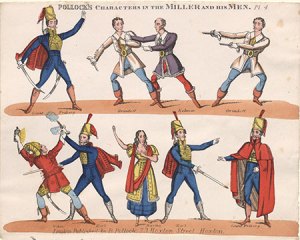From the 16th to the mid-19th centuries, the general public looked to the broadside for news of the latest sensational crimes, murders and executions. As one of the most popular forms of street literature, broadsides were the tabloid newspapers of their day, selling near the gallows on execution days for just a penny. Public hangings were virtually a form of entertainment, attracting large crowds eager for a grandstand view of the proceedings, and the broadside vendors were ready to shout their news the moment the accused was “launched into eternity.”

The execution of John Akrill
This example, entitled Some particulars of the execution of John Akrill, is typical of the broadside format. A single sheet of paper printed on one side, the broadside usually included an account of the crime, a woodcut illustration (in this example, a scene depicting the execution), a description of the convict’s final hours and his last dying confession. The latter was often given in the form of a cautionary verse, emphasising the sorrow of the convict and warning readers of the dangers of drink and bad company. John Akrill, the unhappy subject of this particular broadside, was sentenced to death in 1827 for the crime of horse stealing, one of nearly 500 offences at that time punishable by death.
While many thousands of broadsides were printed, the market was dominated by only a few printers. Profits depended on the printer’s ability to produce and sell broadsides quickly and cheaply, and production costs were kept to the bare minimum. Woodcuts could be reused as the occasion demanded, and stock illustrations of the gallows even had a removable section designed to accommodate the required number of hanging bodies!

The gallows
Broadsides were often prepared far in advance of the execution date and were notoriously unreliable, containing numerous printing errors and inaccuracies of all kinds. Many, if not all, of the gallows speeches and confessions reported were completely fictional, while some printers even reused entire texts, changing only the names.
The John Johnson Collection of Printed Ephemera contains several hundred crime broadsides, all of which are being catalogued and digitised as part of the joint Proquest and Oxford University project, The John Johnson Collection: An Archive of Printed Ephemera. – Ken Gibb
Images:
Some particulars of the execution of John Akrill. John Johnson Shelfmark: Crime 1 (4) (ProQuest durable URL)
The last dying speech and confession of Thomas Howard. John Johnson Shelfmark: Crime 1 (97) (ProQuest durable URL)
Copyright © 2008 Bodleian Library, University of Oxford. Reproduced with the permission of ProQuest. Further reproduction prohibited without permission
Comments are welcome for sharing with other users, but regrettably the editors of Curators’ Choice are not necessarily able to respond to enquiries.



 Posted by johnjohnsonproject
Posted by johnjohnsonproject 


